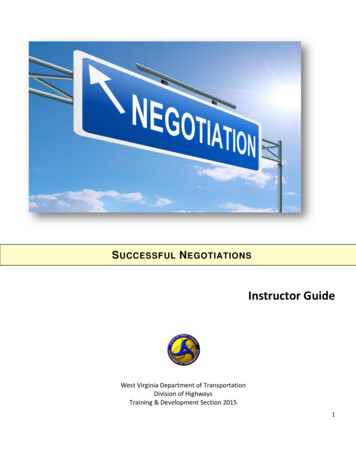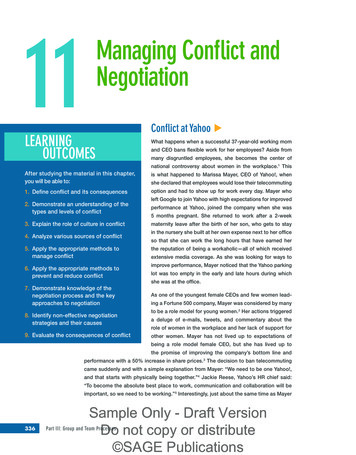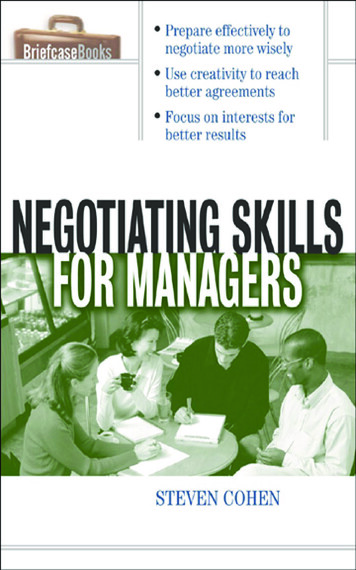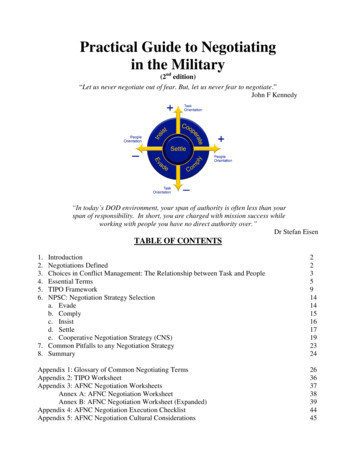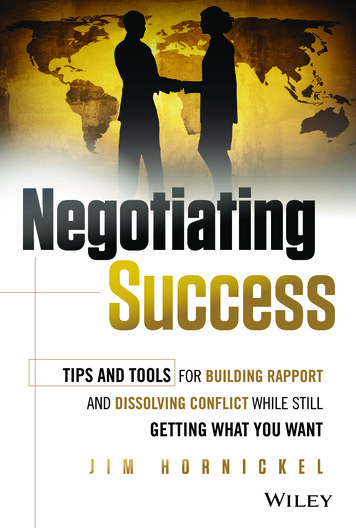
Transcription
3GFFIRST10/26/20130:6:37Page iPraise for Negotiating Success“Jim Hornickel has crafted a book that requires fearless self-examination and awillingness to change how you operate. This book is filled with practical tools forprofessionals who seek to be more effective in a matrix structure. He doesn’t attempt toassert conflict avoidance; rather, he constructs an open and systematic program toreduce the opportunity for misunderstandings and win-lose scenarios.“Hornickel provides a straightforward approach to developing a comprehensivemethod to effectively communicate via a personal code of conduct and sharing that codewith your collaborators. I’d recommend this for anyone who works in an environmentthat requires negotiations.”—Dietrich Thompson, HR Manager, Microsoft Corporation“Negotiating Success is an inspiring book whose time has come. While hard skills arecritical in negotiations, soft skills make up the essential ingredients that supportmutually agreeable gains. Jim’s blend of the two shows how to make the negotiatingprocess human again. His approach on supporting the other in getting what they wantinvokes reciprocal behavior. This book shows that conflict is not inevitable for sessionsto be successful. The reader will raise his/her emotional intelligence, learn the principlesof ethical influence, and still come away with the skills and steps to negotiateintelligently. Hard skills with soft edges; that’s the winning formula!”—Michael ConnorBridge Partnership, author of Insights of a Father,www.insightsofafather.com“In addition to being right on target with teaching and polishing negotiating skills, thisis a page-turner! Leave it to you, Jim, to create a great teaching manual and an enjoyableread! Nicely done, my friend.”—Jeff Eisensmith, Department of Homeland Security,Chief Information Security Officer“This book is exhaustive, concise, simple, and accessible to everyone. You find all youneed to know to master negotiation, techniques, processes, and examples.“The knowledge shared with the reader is useful and applicable in manysituations or moments we face in life. I would recommend it not only to a salesperson or project manager newly appointed, but also to students and young adultsstarting in life, parents, and teenagers.“This approach gives equal importance; first to the people, and second to thetechniques engaged in the negotiation process. The whole negotiation is seen as asuccessful relationship between individuals and not a game you must win.”—Laurent Belle-Perat, Schneider Electric, Global Marketing,Saudi Arabia; Internal Marketing andCommunications Manager, Middle East
3GFFIRST10/26/20130:6:37Page ii“Jim Hornickel is a master at negotiations and relationship building. Throughout thisthoughtful book on negotiation skills, Jim brings sensitivity to the negotiating relationship so that all parties feel honored and well-satisfied with the outcomes. Jim has sharedhis negotiation insights in a way that adds real depth and fulfillment to the myriad ofinteractions we have each day at work, home, and play.”—Suzanne Guthrie, editor of Managing From The Inside Out“Negotiating Success is not just another book on negotiation, but instead presents aunique and brave approach to win-win from a genuine and human perspectiverather than a clichéd one. It concisely presents the best in negotiation research andtechniques and offers practical advice that will inspire negotiators in any situationto live up to the highest standards of their profession.“Going beyond commonplace, overly simplistic and counterproductive tactics,it provides an innovative and thoughtful alternative. In an overcrowded category,Negotiating Success differentiates itself by challenging the reader to take a holisticand elevated approach to negotiation with skills, techniques, and personal developmentthat works!”—Vito Loconte,VP, Global Client Finance,United Kingdom IPG Mediabrands“Negotiation is something that occurs on a daily basis—from a small conversationregarding a work task completion to a more complex agreement on contractual KPI’s.Having a resource that can offer a guide for the interacting process that dissolves conflictand builds rapport is so important. This book serves this purpose in a clear andcomprehensive manner, effectively contributing to working relationships that facilitatethe necessary pace of today’s working world.”—Sarah Sexton, HR Manager,MWH Global, Doha, Qatar“The fortunate ones who read Jim’s work will have an epiphany. The suggestion that allhuman interaction involves negotiating is profound. Focus outside of the workplace andrealize the broad application his book provides. It can facilitate beneficial dialoguebetween spouses, children, neighbors, and practically everyone with whom we come incontact.“Additionally, leading with mutuality and respect will result in more simplenegotiations, stronger relationships, and a rewarding career . . . a must read!”—Robert Torsey, Management Consultant(Former VP at ALCOA)“Negotiations are sometimes seen as (hard) games, with a winner and a loser. With thisbook, Jim brings back the humanity in negotiations. If you want to bring yournegotiation skills to the next level or . . . see negotiations from a whole differentperspective, you should read this book! It not only gives you thorough backgroundinformation, but it also gives you very practical ‘next steps’ that will take you through theprocess.”—Gabby Staal, President & Founder of LeaderQuest,Partners in Evolution, The Netherlands
3GFFIRST10/26/20130:6:37Page iii“Jim Hornickel delivers the essential keys to successful negotiations: combining thehard skills with the soft edges that create constructive outcomes for all parties.“Embrace the tools and principles of Negotiating Success so you’re fully prepared inadvance of all your meaningful negotiations. Learn to stay true to your values, foreseeothers’ needs, motives and desired results, and move confidently through any discomfort and uncertainty on the path to establishing a win-win.“It’s all here, structured flexibly so you can organize and leverage the tools that bestsuit your background, situation, and intentions. Enjoy the process—and make the worlda better place while you’re at it.”—Ken Jacobsen, President, CourageWorks, Inc.“Jim Hornickel has drawn from such diverse disciplines as neurology, psychology, andphysiology to deliver a transformative book which is conversational and interactive.Scenarios, examples, and templates allow the user to holistically integrate the concepts.Thought provoking questions for self-inquiry go beyond just teaching theory tofacilitating inner shifts in awareness. This prepares the reader for skilled negotiationby starting with self-knowledge and moving to understanding human nature. FromHornickel’s vast experience in the field he provides clear, solid, proven approaches.Anyone involved in conflict resolution, whether in relationships, business, or diplomaticcommunication, will benefit from reading this.”—Susan LynneManagement ConsultantSusan Lynne Development, Toronto“Every once in a while, a truly insightful and practical guide makes its way to ourcollective hands and hearts—this is the case with Hornickel’s latest book, NegotiatingSuccess. At a time when so many work cultures are embedded in fierce competition andan emphasis on individual success, this publication provides a thoughtful, respectful, andalternative approach to negotiating ‘what you want.’ A highly respected and successfulleader, Hornickel convincingly espouses a win-win perspective as key to achievingmutually successful and satisfying negotiations. This is a book that I will refer to timeand time again.”—Jan Janssen, Manager, Upper Tier Municipal Government,and author of human interestarticles about community, self-care, women,values, consciousness, etc., Ontario, Canada“When emotions are high, intelligence is low. Negotiating Success creates an eye-openingjourney about how we can develop interactions with others using our greaterconsciousness to get what we want when the stakes are high.“Negotiating Success is a must read for anyone looking to improve their personal andprofessional power in effective communications at a deeper level.”—Loretta Peters, Personal Brand andOnline Identity Strategist,www.EnterprisingCareers.com
3GFFIRST10/26/20130:6:37Page iv“Negotiating Success is a must read for anyone who has acknowledged the benefits of winwin negotiating, but has struggled executing at the table. In simple, direct, andactionable language, Jim breaks down the challenges we all face in taking on newhabits or behaviors.“Jim shares the how and why behind breaking negotiating habits that don’t serveyou and learning new ones that lead to a more effective outcome and a better businessrelationship. Having worked with Jim on many occasions, take my word for it and buythis book. Read this book, and then put the message of this book into action!”—Dan Demers, President, ReMission Consulting, Inc.www.ReMissionConsulting.com“CEO’s will find Negotiating Success a detailed handbook for developing win-winnegotiating skills within their team. The book is useful as an introduction to thesubject, but its real value is as a manual to lead a process of continuing to improve theteam’s negotiating and customer relationships skills. Mr. Hornickel writes in a veryconversational tone, mixing advice with real life case studies to develop win-winnegotiating skills within your team.”—Matthew Falls, Partner, Growthers“Negotiating Success answers the question which every human being asks: How can I getwhat I want out of life without the unexpected and unwanted repercussions and, at thesame time, generate and maintain real happiness for myself and others?“Jim Hornickel’s template is the very thing you need to accomplish that whichsecretly drives you and every other human being on this planet.“Don’t read this book. Eat and savor it. Take time to digest it. In doing so, you willwalk into a new you and a new future. A future that you and everyone else will appreciateand wish to duplicate.”—Barry Curtis, Barry Curtis and Associates“Haven’t most of us taken the time to build a reference library, whether it has to do withhealth, cooking, home repairs, investing, and probably a few on relationships? Well,along comes another must-have to add to your collection—Negotiating Success—whichafter you note the subtitle you understand that it will apply to situations you encounterevery day professionally, personally, and otherwise. The bonus is that Negotiating Successis much more than a reference book. It is really a how-to manual which offers in-depthunderstanding on how agreements are formed, compromises developed, and goalsattained, as well as a personal development guide to help us in our daily activitiesinvolving human interaction. Jim Hornickel has left no stone unturned. What a valuablebook he has delivered.”—Joe Harding, Assistant Women’s Basketball Coach,Flagler College
3GFTOC10/26/201312:1:21Page viiContentsIntroductionxiI THE PEOPLE IN THE PROCESS11 Valuing Mutuality, Proactivity, and uality, Proactivity, and R.E.S.P.E.C.T. Summary2 Reviewing Human FundamentalsFalse Self and True SelfCentricitiesReviewing Human Fundamentals Summary3 Expanding Emotional IntelligenceSelf-AwarenessSelf-ManagementSocial AwarenessManaging RelationshipsExpanding Emotional Intelligence SummaryCase Study4 Working with Negotiating 3671923263133353744465051525461636567vii
3GFTOC10/26/201312:1:21Page viiiviiiCONTENTSWorking with Negotiating Styles SummaryUnfolding Case Study69695 Integrating Six Principles of Ethical Influence72The Principle of ReciprocityThe Principle of LikingThe Principle of Social ProofThe Principle of AuthorityThe Principle of ConsistencyThe Principle of ScarcityIntegrating the Six Principles of Influence Summary737780818486886 Dissolving ConflictCode of ConductConflict EscalationConflict De-EscalationDissolving Conflict Summary7 Presenting Your CaseWhy People BuyImage, Productivity, and/or ProfitabilityNumb—Pain—Ready to ActReception ChallengesDoer as PresenterThinker as PresenterTalker as PresenterGuardian as PresenterSummary of Behavior Styles as PresentersSetting Direction—4 A’sSummary of Behavioral Styles 4 A’s Satisfaction PointsUsing Your Voice—The 6 P’sCompetence and ConfidenceComposed BeginningStrong StrideLeader’s StanceBreatheEye 7123123130130130131132132
3GFTOC10/26/201312:1:22Page ixContentsExpressive FaceBody Language and GesturesPresenting Your Case SummaryII THE NEGOTIATING PROCESS8 Understanding Negotiation FundamentalsNegotiation FundamentalsAssumptionsInformation Is PowerDisclosure Establishes TrustOverly Competitive Lose-LoseTrading Value—ConcessionsCreative ThinkingUnderstanding Negotiation Fundamentals Summary9 Creating Range and AlternativesWishStarting PointWho Names the Number First?Bottom LineBATNA—Best Alternative to a Negotiated AgreementWATNA—Worst Alternative to a Negotiated AgreementCreating Range and Alternatives 515615715815916016116210 Concretizing “Why,” “What,” and “How”163Why, What, and HowConcretizing Why, What, and How Summary16316811 Preparing for Your SessionUniting Your TeamPreparing for Your Session Summary12 Discovering All SidesDiscovery Phase170177179181181
3GFTOC10/26/201312:1:22Page xxCONTENTSSkills for Use in DiscoveryDiscovery Phase Summary13 Checking In Before Moving OnCheck-in PhaseCheck In Before Moving On Summary14 Trading for Mutual GainTrade PhaseTrading for Mutual Gain Summary15 Evaluating for ImprovementEvaluate PhaseEvaluating for Improvement Summary16 Disposing of TacticsExposing TacticsThe Use of TacticsDisposing of Tactics 4017 Practicing for Life242Appendix243Index249
3GFINTRO10/25/201321:11:13Page xiIntroductionAll conversations are negotiations. Whether small personalexchanges or large, complex business contracts, we arenegotiating all the time. Two key questions are: “What negotiating skills do you have to work with?” and “Who are you being asyou negotiate?”Negotiation skills have been around since Neanderthalsdetermined who would go out and fight the saber-toothed tiger.What has been added in these recent, more enlightened times isattention to negotiation relationships.You are now embarking on the exciting next steps in negotiating mastery to become ever more aware of using “mutuality”as the way forward. You are at the launch point for taking boldnew directions on how to model, teach, and inspire mutualsatisfaction in negotiations.When negotiations are built on the goal of having both sideswin, magic happens. Individual and company values are met,visions are achieved, and the organization’s needs are fulfilledin the short term and over time. Even in a world that valuescompetition so strongly, when you go for win-win, you will be atthe leading edge of this change.Negotiating involves “hard skills”—steps, phases, andstrategies; but it also requires “soft skills”—building positiveand productive relationships. We address both major areas inthis work.These pages are designed for you to come back to as often asyou require for review. The material in this book is intended tohelp you grow your mastery over the next days, weeks, months,and years. Yours will be a journey of discovery, practice, andxi
3GFINTRO10/25/2013xii21:11:13Page xiiINTRODUCTIONintegration. Each chapter ends with a series of questions toprobe. I suggest that you write/type each answer. Then use theS.M.A.R.T. goal-setting formula shown to make your next stepstoward mastery concrete.I am honored to be a part of your dynamic growth andfulfillment!
3GC0110/25/201321:26:46Page 1IThe People in the Process
3GC0110/25/201321:26:46Page 31Valuing Mutuality, Proactivity, andR.E.S.P.E.C.T.The Negotiating Success model is based on three equally important principles: Mutuality, Proactivity, and R.E.S.P.E.C.T.(see Figure 1.1). Together they form the cornerstones of thenegotiating process.MutualityPeople around the world have been deeply indoctrinated in theconcept of win-lose. Although that may produce some excitementfor a sports event, or create drama in elections, it is simplyFIGURE 1.1 The Cornerstones of the Negotiating Process3
3GC0110/25/2013421:26:46Page 4NEGOTIATING SUCCESSself-defeating in negotiations. The best results in the short andlong run will be to work on behalf of each party getting as much ofwhat is wanted as possible.Changing from win-lose to mutuality, or win-win, takes amental paradigm shift. And change is not easy, but change willcome more quickly if you have an incentive. The motivation tobecome a mutuality-based negotiator is in part the self-servingfactor. You do need to win on “your” side. But so does the otherparty. So why stop with only half of the equation served? What doyou imagine life would be like if we all changed from self-servingonly to self-serving while serving others? Life is full of choices andthis is one of them. And it makes total sense.The principle of reciprocity (more in Chapter 5) says thatwhen we serve others, they will most likely be inclined to returnthe favor. You do not need to “believe” this. Check it out in yourown life. If someone has no interest in helping you, are you moreor less likely to help them? But if someone acts in ways thatsupport and serve your cause, are you more or less inclined to helpand support that person? If this is true for you, it is likely true forthe other, too.Like so many of the ideas in this book, mutuality will bestronger in formal negotiations if you practice win-win interactions regularly, everywhere. Here is where the self-serving factorcomes into play again. Although mutuality-based negotiationswork for everyone in the short and long term, there is also apersonal W.I.I.F.M. (What’s In It For Me) involved. What is in itfor you to practice more mutuality in day-to-day life? Here iswhere science and the ancient masters are in agreement.Perhaps, like me, your academic days are a few years back.What we learned could only be what was known at the time. If youwere a classmate of Columbus, you would have been taught, andprobably believed, that the world was flat. Inconceivable nowthat we so clearly know that is not true. Well, the science ofbiology has also continued to expand and grow. New technologicadvances are forever showing us new information. That new
3GC0110/25/201321:26:46Page 5Valuing Mutuality, Proactivity, and R.E.S.P.E.C.T.5information shows how old “knowledge” and “beliefs” need to beupdated. One area of the new biology (circa 1995) is aboutgenome expression: epigenetics. What does this have to dowith negotiations? We are talking about the satisfaction involvedin mutuality.Here is how it works. Science (via the Swiss physicianFriedrich Miescher) had its first rudimentary identification ofDNA in 1869 (it was always there, but like many things, we simplycould not see it). Then we could not understand it. Then we havewhat we think is the understanding. Then that understandingchanges. In the mid-1990s, Dr. Bruce Lipton and others, with thehelp of ever-advancing technology, found a major differenceabout DNA. It was said that DNA is the blueprint of life. Itwas thought to determine lots of who we are and what we do. Butthe new science observed that while DNA is indeed a blueprint, itis influenced to direct us by energies outside of itself. Simply put,when DNA received signals that are negative (whether fromwithin us or from our external environment), the DNA expressesnegatively. When positive signals reach the DNA, it expressespositively.Let’s take this back to mutuality and personal satisfaction.Studies show this: When people perform acts of service orkindness (the start in mutuality), our DNA likes that and expressesit in ways that feel good to us. Personal satisfaction! The studiesalso reveal that the person receiving the act of service or perceivedkindness also feels good. And happily, even people who onlyobserve acts of service also feel just about as good as the giver andreceiver. All influenced by positive genome expression.Take these human factors into the negotiation sessions.When making offers and trading concessions with positive givingand receiving, the process feels better. The outcomes are morerewarding to both parties. The memory of that serves well infuture negotiations. If you doubt that, remember how you felt andwhat thoughts you had when you were bargaining with peoplewho only had their own self-interest in mind. Did their methods
3GC0110/25/2013621:26:46Page 6NEGOTIATING SUCCESSinspire you? Probably the opposite. For most of us, when we feelpushed too hard by someone who is out to get concessions fromus but not give back in return, we go to acting the same way. Thatbecomes win-lose. In the long run, win-lose is really lose-lose.You are bound to go into next negotiations with a jaundiced eyeand ready for combat instead of intelligent exchanges.To finish this small look at mutuality, it remains true thatthere will always be some professionals who are so deeply programmed in win-lose that you simply will not inspire them tochange. You will be forced to do what you need to do to get whatyou and your organization wants. That is reality. But life is allabout doing what you can, when you can, with whom you can. Letus take that into the next section on proactivity.ProactivityBecause of the deeply entrenched win-lose training we havetalked about, the ball will often be in your court to lead theway to mutuality-based negotiating. What an amazing opportunity each one of us has to influence positive change. And again, thebeauty of this positive change is that everyone wins.Start the shift now. Begin with yourself. Reflect on yourcompetitive attitudes and actions. Do they serve you as effectivelyas a win-win approach would? Try little experiments of asking forwhat you want while seeing how you can help others get what theywant, too.For example, a parent has been in the habit with his or herchild of often saying no. Mom has been working at her demandingjob all day and when she gets home, she just wants to kick back fora while and read the newspaper. Son Mike says to her, “Mommy,would you play cards with me?” Instead of an immediate no,consider that Mike might simply need some of your time andattention. Playing cards is just one strategy that could get himthat. In a mutuality-based interaction, you might ask Mike to get
3GC0110/25/201321:26:46Page 7Valuing Mutuality, Proactivity, and R.E.S.P.E.C.T.7up on your lap and read some of the newspaper to him. That couldbe win-win. Creativity is a key component of finding mutualroutes to satisfaction. We return to expanding creativity later inthis book.Remember, it will most likely be you who has to lead the wayto learning that there are more rewarding ways of negotiatingthan the ingrained competitive, win-lose approach.R.E.S.P.E.C.TBy now you might accept that mutuality-based negotiations aregood for everyone. You might also be musing on how you can bemore of a leader in proactively infusing the negotiations processwith win-win attitudes and actions. We now take a look at how thequalities and practices of R.E.S.P.E.C.T. will add to the positivepossibilities. We take a peek into how respect-laden negotiationswill serve you and the party you are trading with.R. esponsivenessWhat is responsiveness? The dictionary definitions include:answering and replying, reacting to suggestions, influences,appeals and efforts. Negotiations entail a series of exchanges.More specifically, they involve exchanges of information, ideas,suggestions, requests, and concessions. The more the communication is one-sided during the process, the weaker one side feels:disempowered. That party will be less motivated to share criticalinformation. And withdrawal or withholding imposes unhelpfullimits. Less information with reduced cooperation does not serveeither side!Increasing responsiveness then is a mutually beneficial attitude and practice in negotiations. Starting in the Discovery Phase(Chapter 12), make it clear that you intend on being responsive totheir needs and that you expect them to be responsive to yours.
3GC0110/25/201321:26:468Page 8NEGOTIATING SUCCESSReciprocity! Clearly get their agreement and do not proceed untilyou do so. If you are responding to their arguments but they arenot responding to yours, stop the process and remind them thatyou both agreed to responsiveness as an integral part ofnegotiating.For example, let us say that you have been in a fairly goodflow of information exchange and, at some point, the other partyputs a brake on the flow. If you are consciously, actively aware ofthe responsiveness factor, you know to stop the negotiation andexplore the new gap. What has occurred to change the otherparty’s cooperation? What possible pressures have arisen forthem? Are they using a tactic? (More to come in Chapter 16.)Paying attention to responsiveness will only serve to help movingforward or regain the flow of mutually beneficial exchange.E. mpathyWhat is empathy? Various dictionary definitions include: theability and willingness to understand and relate to the feelingsof another. Both sides will come into a bargaining session withworries, unmet goals, personal pressures, and needs. That is justthe way it is. Empathy is the willingness and ability to put yourselfin their shoes as best you can. You must intellectually understandtheir problems and, more critically, feel their pain.Why is emotional connection to someone else’s pain important? Most behavior styles appreciate when someone outsidethemselves can relate. They do not feel so alone. In mutualitybased negotiating, the whole idea is to constantly relate to theother party’s need throughout the negotiating process (even asyou take care of your own needs). And one area of needs will beemotional, even if it is not openly spoken about (more on emotional intelligence in Chapter 3).Let us stress that empathizing is not agreeing; it is simplyacknowledging something that is truly going on for the otherperson.
3GC0110/25/201321:26:46Page 9Valuing Mutuality, Proactivity, and R.E.S.P.E.C.T.9Also remember that the old demand to “leave your emotionsat the door” is pretty much impossible for human beings. We canmanage to the best of our ability, but part of our very biologicalstructure is to have emotions. Our brains have a thought and thenour brain sends a chemical message to our body saying “thisthought equals this emotion.”Think of a time in your life when you were especiallytroubled by some event or circumstance. It does not matterwhether it was at work or home. And pick an instance whensomeone around you let you know that they could relate to whatyou were going through; that they cared about you. Most of usappreciate that. Most people feel supported by what the persondid or said. That feeling of support creates a certain level ofbonding. And negotiations simply go better when the participantsfeel more rather than less connection with the other. In mediation, a form of negotiation, the first thing done is to find commonground. Empathy helps establish common ground.Please, do not believe or disbelieve this but check it out in therelationships in your own life.So, the unmet goals, pressures, needs, and so on, will be partof just about any negotiation. And that predictability will serveyou. Anticipate that you will have ample opportunities to empathize with their situation(s). Find ways to relate via empathy. Thiscommon ground will absolutely enhance the relationship betweenor among you.Here is one last suggestion: Tailor your empathy to the styleof the other party, using your knowledge of their negotiation style(from Chapter 4). Everyone processes differently, and one style ofempathizing will not be right for all personality types. To beeffective, you have to meet people where they are.S. erviceMutuality-based negotiating means being of service to each other.Think of customer service. What are all of the personal traits and
3GC0110/25/201321:26:4710Page 10NEGOTIATING SUCCESSeffective behaviors that make a good customer service interactionfor you? Do you appreciate when someone is attentive andresponsive to your needs? Treats you like you want to be treated?Has a “Can Do!” attitude and set of actions? How pleased are youwhen someone serves you? How displeased are you when you getpoor service?The same effects of providing good or poor service are partand parcel of the negotiation process. Imagine these approachesbeing used with you from the other party: respectfulness, honor,truthfulness, caring, positive attitude, honesty. Imagine actionsthat include: deep listening, quick and thorough responses, organized interchanges. These approaches and actions are all aspectsof good service—negotiations thrive when they are present.An example: You have done your preparation (Chapter 11)for a negotiation session. You know what you can and cannotoffer. You start the conversation in the discovery phase bydesigning an agreement that states that each of you will workwith the other (to be of service) to have a good enough, win-winoutcome. The other side asks for a concession. Again, you knowwhat you can and cannot give. In a strong but empathetic voice,you say, “Well, we can’t give you that, but here is what we can giveyou.” If what you offer is needed by the other side, there will be afeeling of service connected with the exchange. Constantly lookfor ways to serve the people and the process.P. erspectivesWhat is a perspective? It is frequently defined as a point of view,belief, or opinion.When two or more parties come together in the negotiationprocess, there are likely to be at least two or more perspectives todeal with. In fact, every aspec
Nov 13, 2018 · negotiating skills within their team. The book is useful as an introduction to the subject, but its real value is as a manual to lead a process of continuing to improve the team’s negotiating and customer relationships skills. Mr. Hornickel writes in a very conversational tone, mixing
